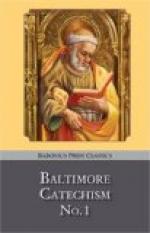upon Him; and yet it seems our patient Lord said not
a word in complaint. Then they put His garments
upon Him, and Pilate asked the people what he should
do with Him, and they cried, “Crucify Him.”
It was then Friday morning, and probably about ten
or eleven o’clock. They made a cross of
heavy beams, and laying it upon His shoulders, forced
Him to carry it to Calvary—the place of
execution, just outside the city; for it was not allowed
to execute anyone in the city. Our Lord had not
eaten anything from Thursday evening, and then with
all He suffered and the loss of blood, He must have
been very weak at eleven o’clock on Friday morning.
He was weak, and fell many times under the Cross.
His suffering was increased by seeing His Blessed
Mother looking at Him. When He arrived at Calvary
they tore off His garments and nailed Him to the Cross,
driving the rough nails through His hands and feet.
It was then about twelve o’clock. From
twelve to three in the afternoon Our Blessed Saviour
was hanging on the Cross, with a great multitude of
His enemies about Him mocking and saying cruel things.
Even the two thieves that were crucified with Him
reviled Him, though one of them repented and was pardoned
before death. Our Lord’s poor Mother and
His few friends stood at a little distance witnessing
all that was going on. When Our Lord was thirsty
His executioners gave Him gall to drink. At three
o’clock He died, and there was an earthquake
and darkness, and the people were sorely afraid.
But you will ask, how could these soldiers be so cruel?
They were Romans; and in those days men called gladiators
used to fight with swords before the Roman Emperor
and all the people—just as actors play
now for the amusement of their audience. People
who could enjoy such scenes as men slaying one another
in deadly conflict would scarcely be moved to pity
by seeing a man scourged. Again, in the early
ages of the Church, during the persecutions, the Emperors
used to order the Christians to be thrown to wild
beasts to be torn to pieces in the presence of the
people—who applauded these horrible sights.
They who could see so many put to death would not
mind putting one to death, even in the most terrible
manner.
79 Q. On what day did Christ die? A. Christ
died on Good Friday.
“Good Friday,” so called since that time.
80 Q. Why do you call that day “good”
on which Christ suffered so sorrowful a death?
A. We call that day good on which Christ died, because
by His death He showed His great love for man, and
purchased for him every blessing.
81 Q. Where did Christ die? A. Christ died
on Mount Calvary.




